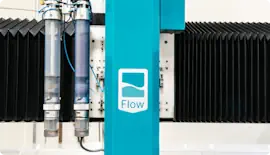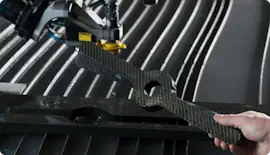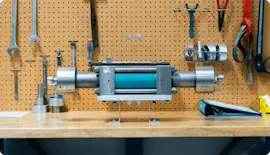How Does Waterjet Compare to Laser, Plasma, or EDM
The 5 Most Common Waterjet Questions - Part Two of Five
There are numerous cutting techniques in metal fabrication. And if you’re reading this, you’ve probably asked yourself, ‘Which is right for me?’Waterjet, laser, plasma, and Electrical Discharge Machining (EDM) are all popular solutions for fabricators and machine shops. However, what’s right for you depends on the type of work you’re doing and your desired outcomes. We’re breaking down each technology to help inform your decision for which process is right for you.
Laser
Laser cutting uses – you guessed it – laser beams to heat and cut through metal during the fabrication process. Unlike some other methods, including water jetting (and EDM), laser cutting is primarily used to cut through metals like steel and aluminum.Laser cutting is an effective method if you need the job done quickly. It’s also relatively accurate.
Things to consider:
While laser cutting is efficient, there are some downsides to consider. For one, laser cutters can’t handle thickness like waterjet cutting can. Typically, these machines are best for surfaces up to an inch thick.In addition, laser cutting requires heat, which can add burn or stress marks to a final product, requiring a secondary finish. Lasers are an option for metals, but it’s limited in the versatility of materials you can cut.
Plasma
A plasma cutter uses gas and electricity to produce plasma, which is able to cut through materials when hot enough. The heat pierces through the metal and the pressurized gas removes the excess metal. The gases used in plasma cutting are usually argon, nitrogen, and oxygen.Plasma is often used to cut metals and can cut through thicker materials than laser. However, laser cutting is faster and more accurate than plasma cutting. Out of the four cutting methods, plasma is the least expensive.
Things to consider:
Similar to laser cutting, plasma can create heat-affected areas on your final product due to its process. Plasma also leaves slag or dross (scum that forms on molten metal) that can often require secondary processing to create a clean edge. It’s also not as accurate as laser cutting or water jetting. The fumes created by the plasma cutting process can also be harmful to those who are operating the machines.Electrical Discharge Machining
EDM uses electrical discharges to cut through metal. EDM is an accurate method for cutting materials of 12 inches or less and often requires little-to-no secondary finish.Since it uses electricity, EDM is only compatible with conductive materials, including alloys and steel. It also will require different wire setups depending on the job.
Things to consider:
EDM is often the slowest of the four processes we’ve discussed, but it can be a great solution for roughing out extremely large parts when a particular edge finish is required, as well as for cutting advanced geometries.Waterjet
Waterjet is an amazing technology that uses high-pressure streams of water to cut through a wide range of materials — thick, thin, soft, or exceptionally hard, and from rough cut to accurately finished edges.Water pressurized at 60,000 psi easily cuts through gaskets, foam, soft plastics, and rubber. When sand is added to the pressurized water – known as abrasive waterjet cutting -- the process can cut through almost any material, including metal and stone.
Waterjet cutting is accurate, can be used on numerous materials up to 24 inches thick for rough cuts, and doesn’t require secondary finishing as it doesn’t create any heat-induced stress or markings on your finished product. Water jetting is a cold-cutting process that leaves a satin smooth edge on your materials and creates minimal kerf.
Ready to Learn More About Waterjet Cutting?
The versatility and efficacy of waterjet sets it apart from other cutting methods. It provides a clean, accurate cut that requires virtually the same setup for each job.Learn more about waterjet cutting and its benefits here. Find webinars, videos, and articles on our resources page.



